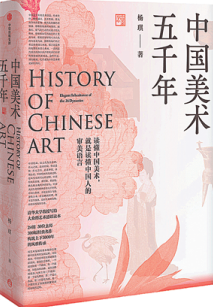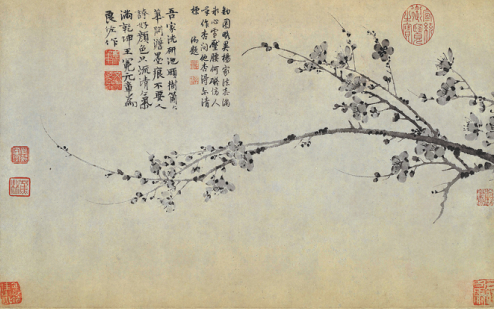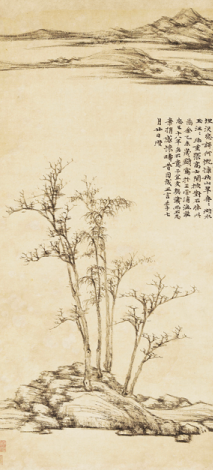Framing a viewpoint
Art historian presents the development of Chinese painting through the dynasties, Yang Yang reports.

For a long time, 87-year-old Yang Qi, a former professor of art history at Tsinghua University, had applied Western art theories to study ancient Chinese art, the core of which sees art as the reflection of social life. But when it came to ink-wash painting masterpieces of the Yuan Dynasty (1271-1368), he found it did not make sense. Yang had always agreed with French philosopher Hippolyte Taine that "in happy times, artists only create happy works, while in chaotic wartime, they produce only melancholic works".
This is true for The Triumph of Death, by Flemish Renaissance painter Pieter Bruegel the Elder, who, Yang says, created the work under the influence of war atrocities in the 16th century. In the appalling painting, a large army of skeletons sweeps a barren landscape and humans, men or women, rich or poor, young or old, all fall under death's scythe.
"It mirrors the chaos caused by war and people's sufferings," he says.
Chinese ink-wash painters in the 13th century also lived in chaotic wartime.
"Their life was painful, they were pessimistic and their future was hopeless. But how did they present that chaotic time?" Yang asks.
"In their paintings, there is no killing, or death, or blood, but refreshing breeze, bright moon, beautiful landscape, plum blossom, orchid, bamboo and chrysanthemum," he says.
"I thought even if they painted plum blossoms, they would be damaged. However, it's not the case," he says.
Instead, plum blossoms by great artist Wang Mian all bloom luxuriantly and vibrantly, he found, which contradicted the theories that he had stuck to and posed a big question to his study: "What is wrong?" He tried to answer this question in the next 10 years.
He proposed different assumptions. "Is it because Chinese painting is inferior to its Western counterpart? Is it because the fashion to imitate 'ancient paintings' in the Yuan Dynasty ruined national art, which gained the look but lost the spirit? Is it because artists in the Yuan Dynasty were flattering people by beautifying the ugly and the fake?"
After overturning these assumptions, with doubts, Yang tried to interpret those paintings from the perspective of artists' inner world, and got unexpected results.
"Wang painted plum blossoms not to express his grief and indignation about the country's fate, his sadness for people's sufferings, or his helplessness in the hopeless future, but to express his pure soul that despised the powerful and the rich," he says.
"The invaders could beat the armies of the Song Dynasty (960-1279), occupy the land, but they could not conquer the painter's heart, which was represented by the plum blossoms in full bloom that neither high wind nor coldness could impair," he says.
That is why the Chinese civilization could survive and continue to today.
Yang says he needed 10 years to capture the essence of Chinese paintings of the Yuan Dynasty partially because the existing books about Chinese art history tend to talk about the artists and their works without telling why they painted in those ways. That might be one of the reasons why he wrote the book History of Chinese Art: Elegant Inheritance of the 24 Dynasties, which came out earlier this year.
"Thirty years ago, I preferred Western art to Chinese art," he says, "because I didn't understand the latter".
"I love Western art mostly because I love books of Western art history that do not only narrate its history but also its developmental law," he says.
For instance, E. H. Gombrich in The Story of Art said that Western art develops following the law-from what is known to what is seen, while Heinrich Wolfflin said in Classic Art that it is from feelings to vision.
"Their conclusions are not necessarily scientific, but they helped me to understand and memorize the works from different ages," he says.
In comparison, writings on Chinese art history are often chronicles, he says.
"They often tell you the painters from different dynasties and their works but there is no summary about the developmental law of the art. Without understanding the rules, how can one understand and memorize so many painters and works?" he says.
Once Yang told about this confusion to his colleague Zhang Gan, who inspirationally suggested to him to employ the research methods of Western art history to study its Chinese counterpart. He then spent the next 30 years preparing the book, aspiring to write one like The Story of Art.
"History of Chinese Art is a book that not only narrates the development process of Chinese art, but reveals its developmental law," he says.
As he observes, basically the tree of painting art first buds, then thrives and ultimately declines. Based on this fundamental law, Yang first chose works when artistic styles first emerged. For example, for ink-wash landscape paintings, he first chose those of Wang Wei from the Tang Dynasty (618-907) who started this artistic style, then Huang Gongwang and Ni Zan from the Yuan Dynasty who marked its peak, the representative painters in between, and the painters from the declining period.
Yang organized the book according to dynasties. He first traces the earliest art in ancient China back to prehistoric art-the cliff paintings and carvings and potteries.
Then he introduces bronze ware in Xia (c.21st century-16th century BC), Shang (c.16th century-11th century BC) and Zhou (c.11th century-256 BC) dynasties, the Epang Palace and Terracotta Warriors in the Qin Dynasty (221-206 BC), and stone reliefs and paintings on silk from the Han Dynasty (206 BC-AD 220). He devotes the remaining eight chapters to different painting styles in the following historical periods, mainly figure, landscape and flower-and-bird paintings.
Great Chinese paintings do not pursue the likeness of appearance, but a faithful representation of the spirit.
"The ultimate goal of Chinese painting, just like Chinese philosophy, is to teach people to be good and to purify their souls," he says.
Just like a line from the poem that Wang Mian wrote on one of his representative works of plum blossoms: "They need no comments on their good looks, but simply leave their delicate fragrance in the world."





Today's Top News
- Peace or war: that is the question
- Japan-Australia security partnership not as well-intentioned as claimed
- Xi to attend BRICS leaders virtual meeting
- China initiates emergency response to flooding, typhoon in 2 provinces
- PLA condemns Canadian, Australian warships' Taiwan Strait transit
- Xi extends congratulations to plenary session of China-Russia friendship committee






























